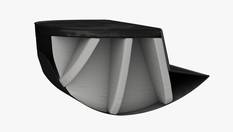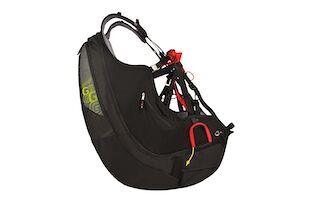How do I choose the right paragliding harness?
You need to work out what style of paragliding harness to look at and that can depend on what environment you fly in. Let me explain by breaking it down into the main harness considerations.
All paragliding harness do a similar thing, but it's now possible to buy lots of lateral and back support or go more minimalist and light weight.
Back protection
You can choose the type of back protection, foam or airbag, sometimes a mix of both.
Foam options
So all harness design is similar as they are webbing based with a seat board or hammock-style I.e. without. 
Foam options come with a physical padded insert generally between 16-20 cm thick to protect your lower spine against hard landings. They have been used for used are bulky but not necessarily heavy, they end up making a larger carrying package, some new paragliding pilots flying on big hills like the idea of them as in windy conditions they do offer a more consistent level of protection if being dragged across the ground where as airbag options once deflated offer little but fabric between you and any rocks
Airbag options
So airbags have gone from being huge baggy ideas with inflation through the seat under your legs, they used to require some time after launch to fill properly. They are well thought off and tested to show the best option for first impact in an accident involving a fall from height as they offer a bubble of air that slowly deflates until near popping. Sound design and even better shaping have made theses types of harness a really useful and practical solution in modern paragliding. 
Modern airbags are generally pre-filled by the time you get to take through a stiffening rod or foam plate to give shape and act like bellow. An additional side vent helps with full inflation within seconds of take off, they are sized according to harness design.
Reserve fitting
Everyone flies with one and only a handful ever need using , that's the way you want it but get what you want and get the best.
Most harness come with an under seat or lower back option, these are the best of the bunch, no one uses shoulder mounted options anymore. They are convenient space wise and generally only accessible with your right hand, there are some brands that offer a left and right handed option.
One option and arguably the the safest but slightly less convenient is the front mounted reserve which allows both hands to reach it in an emergency. The downside for some pilots is that it adds another level of fuss as they sit more of less on your lap in flight.
Geometry
A term described to the behaviour of harnesses in flight, the feedback they give and receive from the gliders pitch, roll and yaw in turbulent and thermic air. There was a period of design back around 2002 where pilots were super keen for as much weight shift and feedback as possible, we've since realised that the downside to this is reduced stability at just about the wrong time that you want it I.e in turbulence.
Sometimes lighter weight harness or poorly fitted harness can offer too much feedback at a time in your flying when a little less rock and roll would be appreciated!
Chest-strap settings are now recommended by manufactures for optimum use of their gliders and are given out online or with a manual when you buy them.
Passive safety characteristics of a wing can be compromised by poor harness strap settings.
Reversible harnesses
These are a relatively new idea, haha well maybe ten years old maybe and of course there are pros and cons.
Reversible harness offers smaller packing size as the wings neatly fold into the centre of the harness when reversed out. By doing this they stow away smaller and reduce the need for a traditional outer bag, meaning less weight.
They also come with an option of seat plated or hammock-style(i.e. each leg is supported by fabric and webbing and move independently to the style of the seat board.)
They prove more comfortable to carry up hills if your local sites need a half-hour walk in.
There is a lot of clever stitching that goes into reversible harnesses and often goes hand in hand with cutting down weight. They don't tend to be as hardy as the traditional foam options so you can't chuck them around in quite the same weigh on the ground or across an airport conveyor belt.
Remember you can buy airbag harnesses without the reversible option and still get the smaller pack.
A note about materials and second-hand gear
Here's something to consider when buying your kit, buying a lighter weight harness does mean that you sacrifice robustness and the potential damage factor that goes with it. Older style harness were made out of Cordura fabric which you could bounce on the ground countless times before you saw wear and tear. For instance FlySpain has over fifteen training harnesses, all less than 3 years old but all made with Cordura and thick foam airbags, they are guaranteed to open and are scruff proof in a teaching environment.
The downside of how great Cordura is means that there are some very doggy old harness on eBay from a time when harness design went through more styling then sensible thought say, they work but you might find they give too much feedback and not enough protection...these harness surface and I guess look the part, so in short if your buying second don't get anything older than six years and you'll not make any obvious blunders.
Harness Sizing
They mostly come in Small, medium, large and XL. Everyone is a different shape and all harness need time to set up to your shape and inflight comfort regardless of how much you spend.
For instance, if your middling weight but have very long legs then an XL harness might well feel too wide and I truth adding a foot stirrup with a large might be the better option.
Pod harnesses
So I can't really see any reason why a new student might buy one of these harness fresh out of school. I appreciate they look good, but they can add extra faff she launching, nits harder to be nimble on launch and run with something hanging around your feet. They can also be a faff to get into and add an extra dimension of rock and Pop in rougher turbulent air which again you might prefer to experience later in your flying. The performance gains are in truth mostly wasted when flying En A gliders and on low airtime pilots.
If your upgrading to a higher-performing wing, thermally and making your first Xc, then there a great deal of choice in pod harness. Many have again followed the design of big and uber heavy to lighter and lighter, you'll have to ponder the pros and cons obviously and bear in mind that the lighter some of these options are the less you get in back protection.
Paragliding Hike and fly harness Options 
So you can go as skinny as you like, there are options out there that are really minimalist, and they look appealing if packaged up with a lightweight wing about the size of someone's handbag.
If your a new pilot then the downsides are too much feeling and wobble in flight and a scarcity of back protection. So if you want to go hike and fly look at some of the manufacturers who now offer a halfway house, say reversible or airbag harness. Once you've spent a couple of years in the sport you'll have a better idea on how to make a more informed choice of harness.
FlySpain has a full time team instructors who've been flying for nearly twenty years, we appreciate the importance to find the right equipment that to suit your flying and build. Feel free to enquire or ask any of our instructors about what equipment they like or recommend and why.


